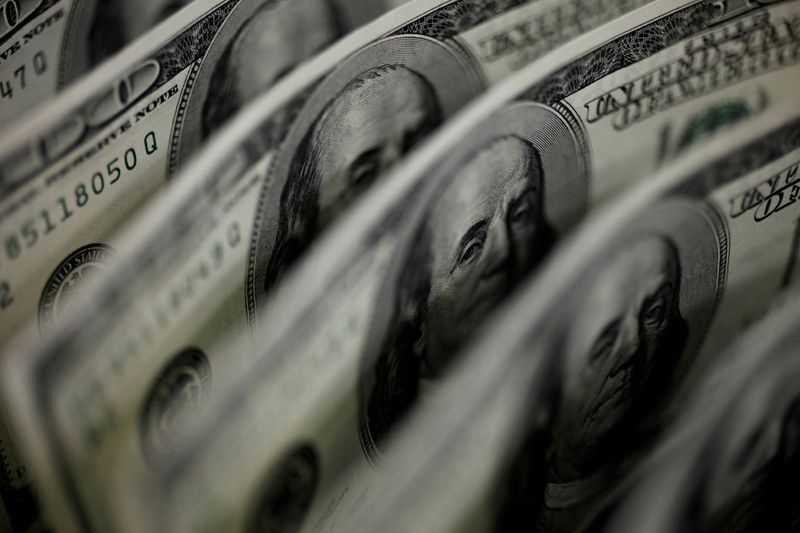By Mike Dolan
LONDON (Reuters) - Even if the U.S. dollar's singular dominance as global currency of choice is in fact ebbing, it may not automatically lead to a weaker dollar exchange rate - and could periodically mean the opposite.
A Federal Reserve less worried about the overspill of its monetary policies to the rest of the world is a central bank more inclined to extreme tightening and easing. And a less dollarised global economy could potentially free the Fed to stay locally focussed - for better or worse - and keep inflation lower over time.
Throughout 50 years of the floating exchange rate era, debate has raged about what 'exorbitant privilege' the United States gleans from the dollar being the world's reserve currency, and numeraire since French leaders first used that phrase.
The big advantage of large dollar reserve holdings alongside wide commercial usage and trade in dollars overseas was clear. U.S. firms avoided added currency volatility in dollar-invoiced imports such as energy and commodities while Washington effectively enjoyed subsidised borrowing as other nations banked precautionary or windfall dollar savings back in Treasury bonds.
The strategic muscle of being able to limit use of the world's most pervasive currency for political reasons - clearer than ever in recent years - was another.
But many have also argued over the years that the dollar's international role often constrained the Fed from conducting policy most appropriate to the domestic economy - due mainly to fear that extreme moves may shock an integrated world financial system with the economic backwash hitting America's economy anyway.
Right now, a similar argument could be made with Fed policymakers chomping at the bit to tighten ever further as a way to drag inflation back to target just as other areas of the world, such as China, are struggling economically, wary of falling prices and looking to ease.
Were that divergence to widen and cause dollar-related stress, might the Fed be minded to tread more cautiously? Or if the cost of dollars were less an issue for the rest of the world than it has been for decades, would it plough on regardless?
So-called "de-dollarisation" has been the subject of endless speculation since the geopolitical re-alignments that followed the pandemic and the freezing of Russia's foreign reserves after it invaded Ukraine last year.
Even though reductions in dollar holdings and usage have been relatively small despite higher perceived sanctions risk, the BRICS group of Brazil, Russia, India, China and South Africa - and already heavily-sanctioned economies such as Iran and Venezuela - have certainly urged carving dollars out of trade and investment ever since.
But the issue is typically read in markets as a reason to bet on a weakening dollar exchange rate - or even to pump alternatives such as gold or crypto tokens.
It may not necessarily work that way - especially if it leads to a tighter Fed, higher bond yields and lower inflation over time.
'OASIS'
One of the clearest examples of Fed hesitation was when Alan Greenspan's team cut rates three times in 1998 despite a briskly growing U.S. economy and developing tech boom, arguing the United States could not remain a 'oasis of prosperity' in a global emerging market storm and credit jolt that the Fed's sharp tightening of 1994 had arguably whipped up.
By late 1999, the Fed had quickly reversed all of those cuts and was then forced to tighten three further times to a peak of 6.5% - eventually pricking what had by then become a runaway dot.com bubble.
Of course, that was a global economy riven with fixed dollar exchange rate pegs that supercharged the transmission of Fed policy, most of which have since been dismantled.
And the Fed now has many other tools - such as multilateral dollar swap lines - to ease stress.
But it wasn't the only time Fed policy was clipped or influenced by dollar pressure overseas.
Before taking up her current role as Treasury Secretary, Janet Yellen recalled her time as Fed chief and claimed that when the prospect of Fed tightening in 2015 led to massive capital outflows from China and unnerved world markets, it forced the Fed to pause its rate hike campaign.
The opposite has also been true.
As the Fed embarked on quantitative easing for the first time after the great financial crash in 2008, there were howls of protest from emerging powers such as Brazil about the United States embarking on 'currency wars' to weaken the dollar for trade gain.
Yellen also recounted G20 meetings as Fed chair in which criticism arrived whether the Fed was easing or tightening, with complaints mostly about extremity in policy moves, and the Fed was "sensitive to these concerns".
Fed studies - including one from Fed board economists on 'spillovers' late last year - show a much bigger exchange rate impact from Fed tightening in their model of 'dollar dominance' than a benchmark situation without it - suggesting much less overseas impact in the latter and more scope for higher rates.
"Central banks around the world do take into account these spillovers and internalize them," they said. "But policymakers have a tough balancing act to manage."
At the very least, a world less sensitive to the dollar because it uses it less for trade and reserves may also be a world of structurally higher U.S. interest rates - and maybe a more volatile one to boot.

That may be a world many countries prefer if they are sure of viable alternatives - but may not mean a weaker dollar.
The opinions expressed here are those of the author, a columnist for Reuters
(by Mike Dolan, Twitter: @reutersMikeD.; Editing by Kirsten Donovan)